The Tadpole Nebula (IC 410) is an H II region located approximately 12,400 light-years away in the northern constellation Auriga. It is associated with the young open cluster NGC 1893. The cluster has an apparent magnitude of 7.5 and an apparent size of 11 arcminutes. It is an easy target for small telescopes.
The dusty emission nebula IC 410 is ionized by five hot, blue, O-type stars, HD 242935 (O7.5V), BD +33 1025 (O7V), HD 242908 (O4.5V), HD 242926 (O7Vz), and TYC 2394-1214-1. These massive stars are believed to be the main sources of ionization in the region. They emit high-energy ultraviolet protons that excite the nebula and make it glow.
The nebula is more than 100 light-years across. It is part of a larger star-forming region that is also home to the nearby Flaming Star Nebula (IC 405).
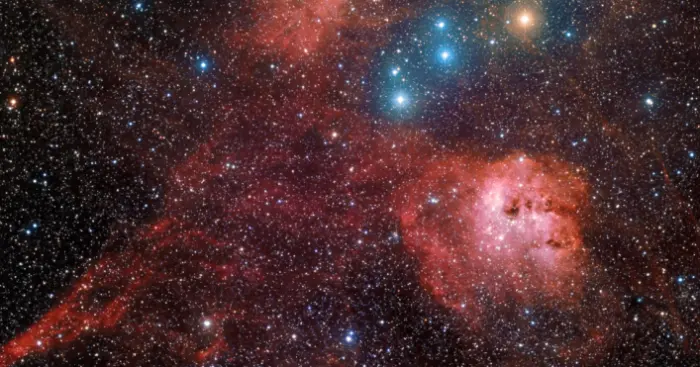
The Tadpole Nebula (IC 410), image credit: Giuseppe Donatiello (CC0 1.0)
The star cluster NGC 1893 is embedded within the Tadpole Nebula. The estimated age of the stars of NGC 1893 is about 4 million years. These stars are members of the larger Auriga OB2 association.
IC 410 was named the Tadpole Nebula because it hosts tadpole-shaped dark dust clouds that appear as if they were swimming toward the center of the nebula.
The tadpoles of IC 410 are gas globules, small dense knots of dust and gas that give birth to young stars. They are composed of denser and cooler dust and gas.
Stretching about 10 light-years across, these dense structures bear a resemblance to the better-known Pillars of Creation in the Eagle Nebula (Messier 16). Their heads are marked by bright ridges of ionized gas. The tails of the tadpoles point away from the core of NGC 1893 because of the radiation pressure and strong stellar winds from the young stars in the cluster. The tadpoles are sites of ongoing star formation.
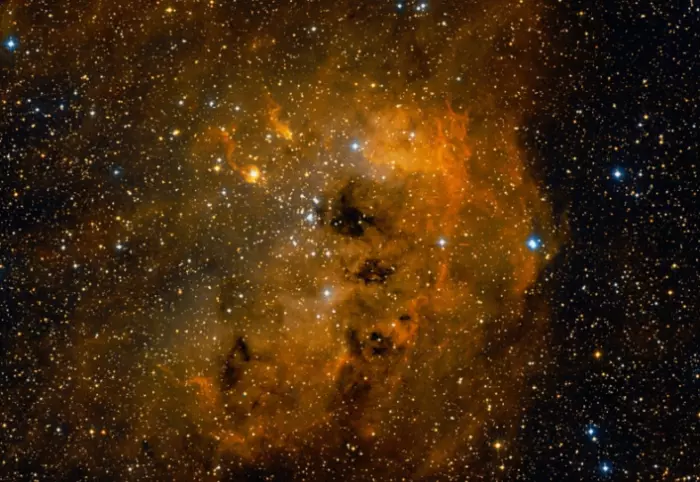
The Tadpoles in IC 410 (bright orange filaments to the upper left of centre), image: Wikisky
The intense radiation and fierce stellar winds from the newly formed stars erode and sculpt the two gas structures. In a few million years, the clouds of dust and gas will have dissipated and all that will be visible are the young stars that are now still embedded in clumps of gas.
The two smaller emission nebulae have their own designations, Simeis 129 and Simeis 130. Most pre-main-sequence stars with emission lines in NGC 1893 were found near Sim 129 and Sim 130, as well as in the nebula’s central regions.
A 2012 study identified 53 variable pre-main-sequence stars in NGC 1893. The team of astronomers who conducted the study found that the rotational period of these young stars decreased with stellar mass and age.
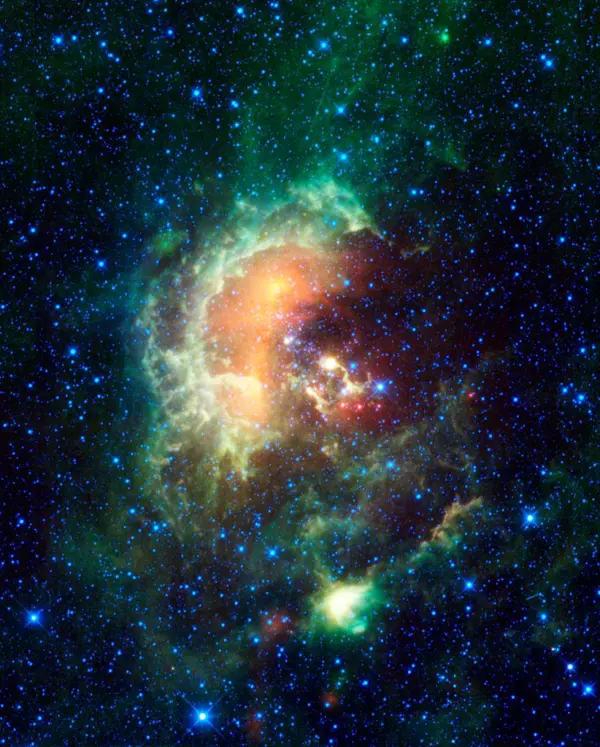
This Tadpole region is chock-full of stars with ages as young as only a million years — infants in stellar terms — and masses over ten times that of our Sun. It is called the Tadpole nebula because the masses of hot young stars are blasting out ultraviolet radiation that has etched the gas into two tadpole-shaped pillars, called Sim 129 and Sim 130. These “tadpoles” appear as the yellow squiggles near the centre of the frame. The knotted regions at their heads are likely to contain new young stars. Twenty-five frames of the region, taken at all four of the wavelengths detected by WISE, were combined into this one image. Image credit: NASA/JPL-Caltech/WISE Team
A 2013 study of the 20 nearest massive star-forming regions to the Sun found a total of 4,600 young stellar objects in the Tadpole Nebula. The study was based on observations with the Chandra X-Ray Observatory in the early 2010s. 67 young stars were unclustered and 98 were members of subclusters. NGC 1893 is older than most massive stellar nurseries mentioned in the study and does not have a dense stellar core.
Astronomers find NGC 1893 to be an interesting target for studying the formation of stars in an environment that is different from the solar neighbourhood. A 2004 study found that the stars in the cluster are forming in a low-metallicity environment. It is generally believed that star formation in the outer Milky Way is less vigorous because of low metallicity and a lack of supernova events.
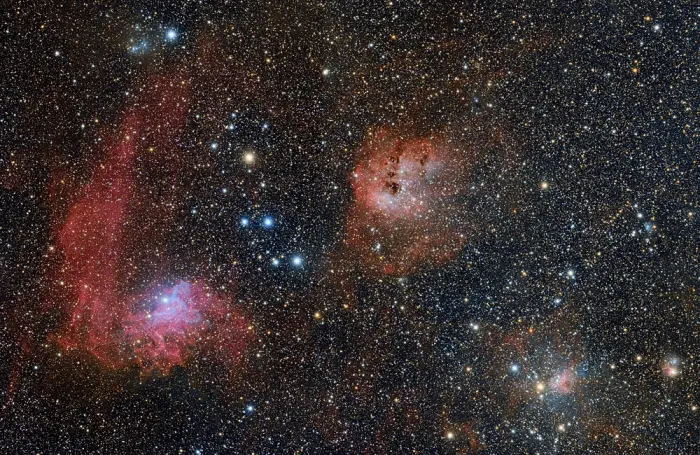
The Tadpole Nebula (IC 410, centre) and the Flaming Star Nebula (IC 405, left), image credit: Wikimedia Commons/Keesscherer (CC BY-SA 4.0)
Location
The Tadpole Nebula appears within Auriga’s hexagon, not far from the Flaming Star Nebula (IC 405) and the bright open clusters Messier 36 and Messier 38. The nebula lies in the region between Hassaleh (Iota Aurigae) and Mahasim (Theta Aurigae), just below the imaginary line connecting the two stars and close to the line extended from the bright Capella (Alpha Aurigae) to Elnath (Beta Tauri).
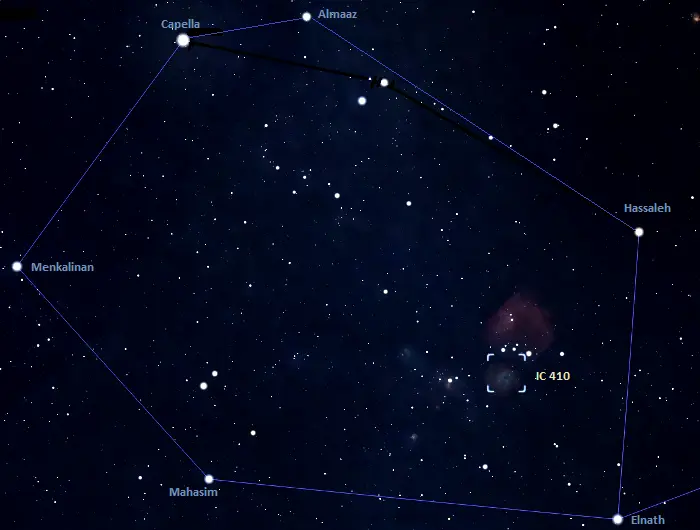
The location of the Tadpole Nebula, image: Stellarium
IC 410 appears in a region full of bright deep sky objects. The Flaming Star Nebula, an emission and reflection nebula surrounding the young variable star AE Aurigae, appears only about 1.5 degrees to the west. The Spider Nebula (IC 417) and the Fly Nebula (NGC 1931) lie to the north and northeast, as do the Messier clusters M36 and M38.
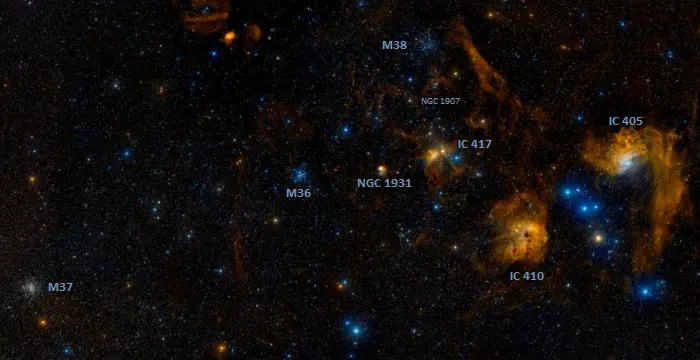
Deep sky objects in Auriga, image: Wikisky
The Tadpole Nebula can be seen in a small telescope in good conditions. The horseshoe shape can be made out in larger instruments. The nebula is best observed with a UHC or OIII filter.
The best time of the year to observe the Tadpole Nebula and other deep sky objects in the constellation of Auriga is during the month of February, when the constellation climbs high above the horizon in the evening.
Tadpole Nebula (IC 410) and NGC 1893
| Constellation | Auriga |
| Right ascension (IC 410) | 05h 22m 00.0s |
| Declination (IC 410) | +33° 29′ 00” |
| Right ascension (NGC 1893) | 05 22 53.8 |
| Declination (NGC 1893) | +33 26 38 |
| Apparent magnitude (NGC 1893) | 7.5 |
| Apparent size (NGC 1893) | 11.0′ |
| Distance (NGC 1893) | 12,400 light-years (3,790 parsecs) |
| Names and designations (IC 410) | Tadpole Nebula, the Tadpoles, IC 410, Sharpless 236, Sh2-236, LBN 807, Ced 43, CTB 17, Min 2-59, W8 |
| Names and designations (NGC 1893) | NGC 1893, Collinder 63, Melotte 33, Lund 166, OCL 439, C0519+333, OCISM 101, Raab 24 |